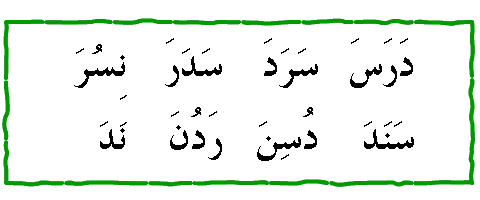|

Note: throughout this lesson you can always listen to
how the words are pronounced by clicking on the images
within the boxes beside this:

In this lesson we will take the four consonants
We start with an Example:

Observation:
-
The shape of these letters ( and the rest of the alphabets
) changes depending on their position in the word, whether:
-
 ( N ) and
( N ) and  ( S ) change shape in order to connect to the letter following
it, they are connective consonents, whereas
( S ) change shape in order to connect to the letter following
it, they are connective consonents, whereas (D)
and (D)
and  (R)
are non-connective. (R)
are non-connective.
So let's summarize using this two tables and then move
to the practice:
In the case of non-connective letters:
| |
Initial |
Medial |
Final |
| |
|
After
non-connecter |
After
connector |
After
non-connecter |
After
connector |
|
D |
 |
 |
 |
 |
 |
|
R |
 |
 |
 |
 |
 |
In the case of connective letters:
| |
Initial |
Medial |
Final |
| |
|
After
non-connecter |
After
connector |
After
non-connecter |
After
connector |
|
N |
 |
 |
 |
 |
 |
|
S |
 |
 |
 |
 |
 |
Practice:
1) case of D
a) in the beginning of the word:
b) in the middle of the word:
c) at the end of the word:
As you may have noticed the long
vowels are written as follows:
| |
After
non-connecter |
After
connector |
|
aa |
 |
 |
|
uu |
 |
 |
|
ii |
 |
 |
2) case of R
a) in the beginning of the word:
b) in the middle of the word:
c) at the end of the word:
The absence of vowels in a word
is called Sukun and is transcribed
 "a small circle" on top of the word
"a small circle" on top of the word
3) case of N
a) in the beginning of the word:
b) in the middle of the word:
c) at the end of the word:
One last thing to note is that
when the long vowel ii is in the middle of the word
it is written as follows:
| |
After
non-connecter
|
After
connector
|
|
ii |
 |
 |
4) case of S
a) in the beginning of the word:
b) in the middle of the word:
c) at the end of the word:
Reading exercise:
Writing exercise:
Join the letters below as in the following example:
Summary
Congratulation ! you have completed the most difficult
lesson in this tutorial, and inshaa'Allah the rest of the
tutorial will seem very easy.
we covered two basic things in this lesson:
-
The shape of the letters changes depending on their
position in the word (this includes the long vowels).
The absence of vowel is called sukun.
This table summarizes how the long vowels are written:
| |
Medial |
Final |
| |
After
non-connecter |
After
connector |
After
non-connecter |
After
connector |
|
aa |
 |
 |
 |
 |
|
uu |
 |
 |
 |
 |
|
ii |
 |
 |
 |
 |
Send me to lesson three
>>
  |